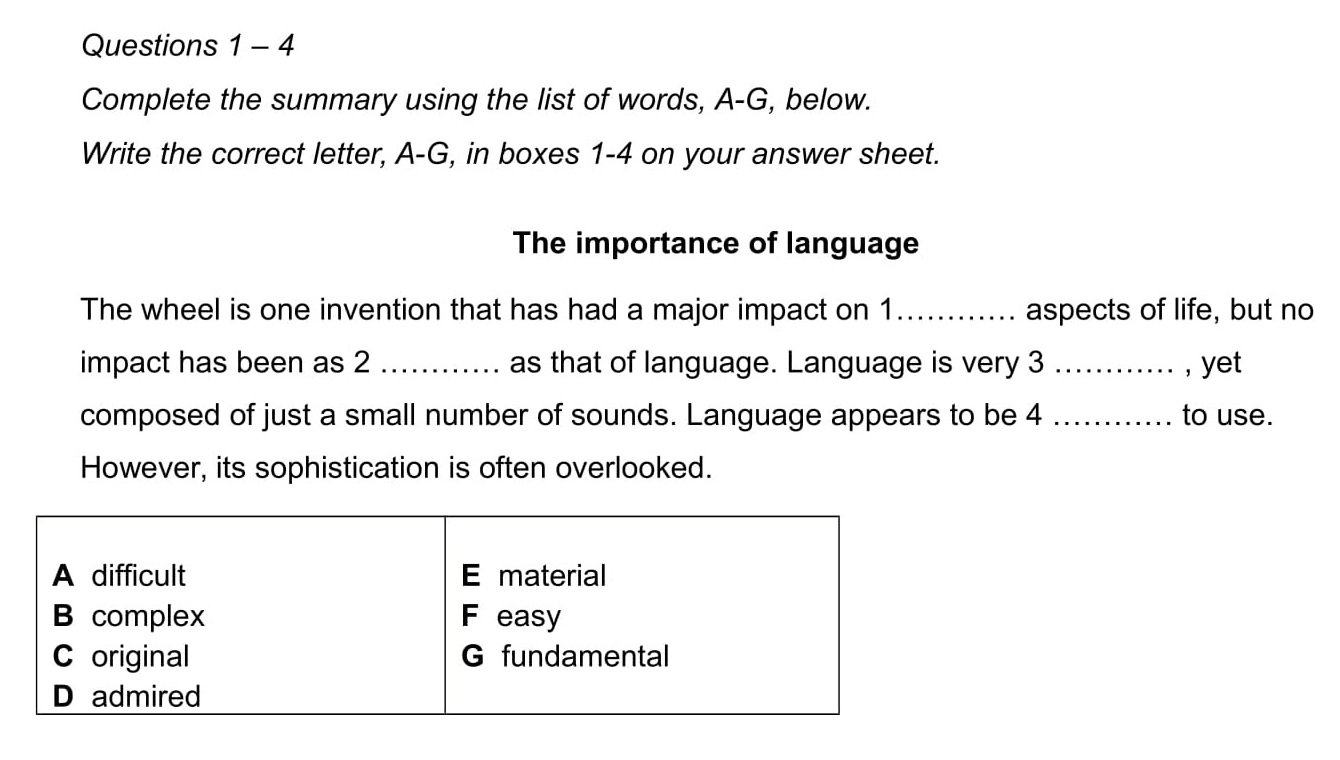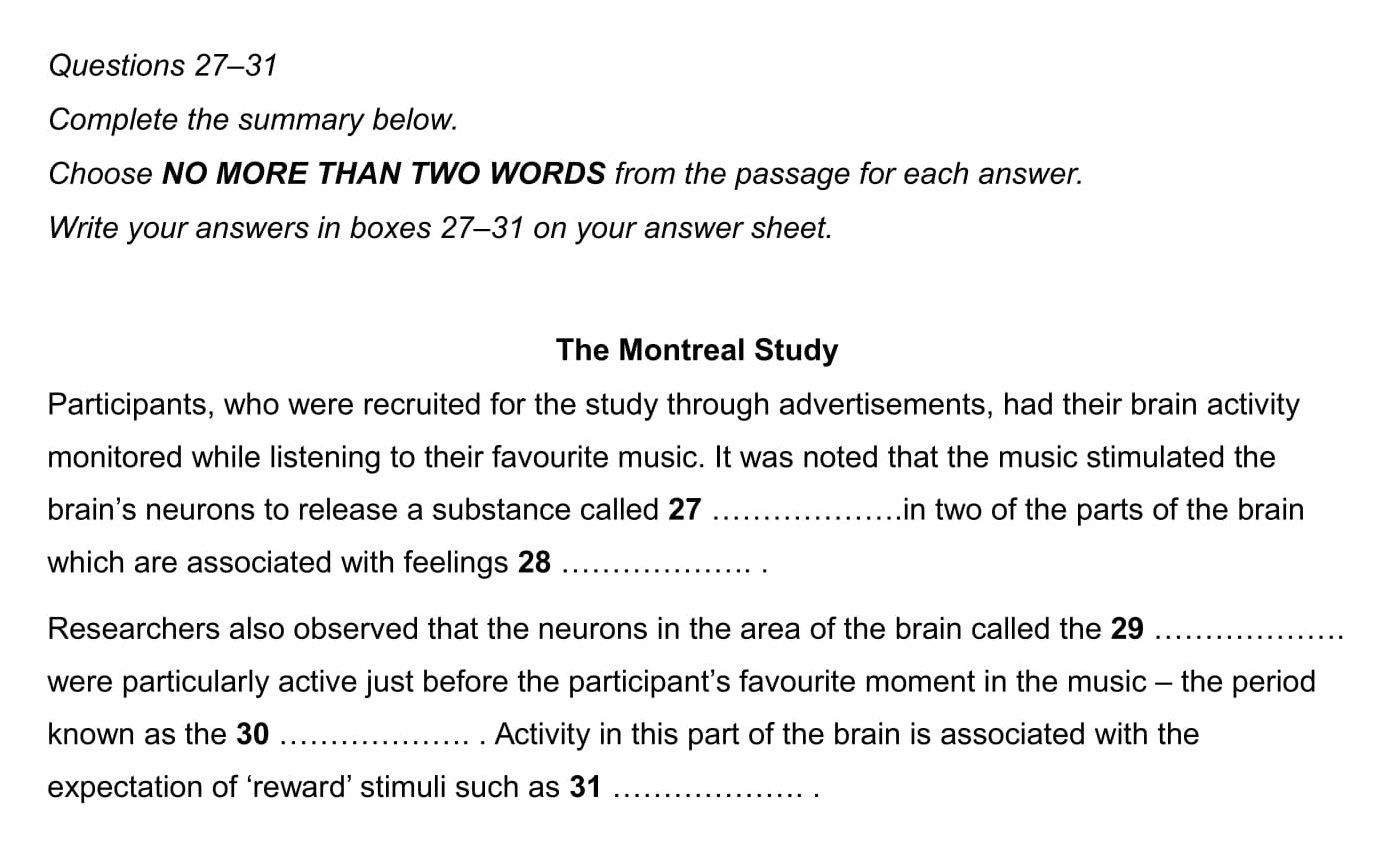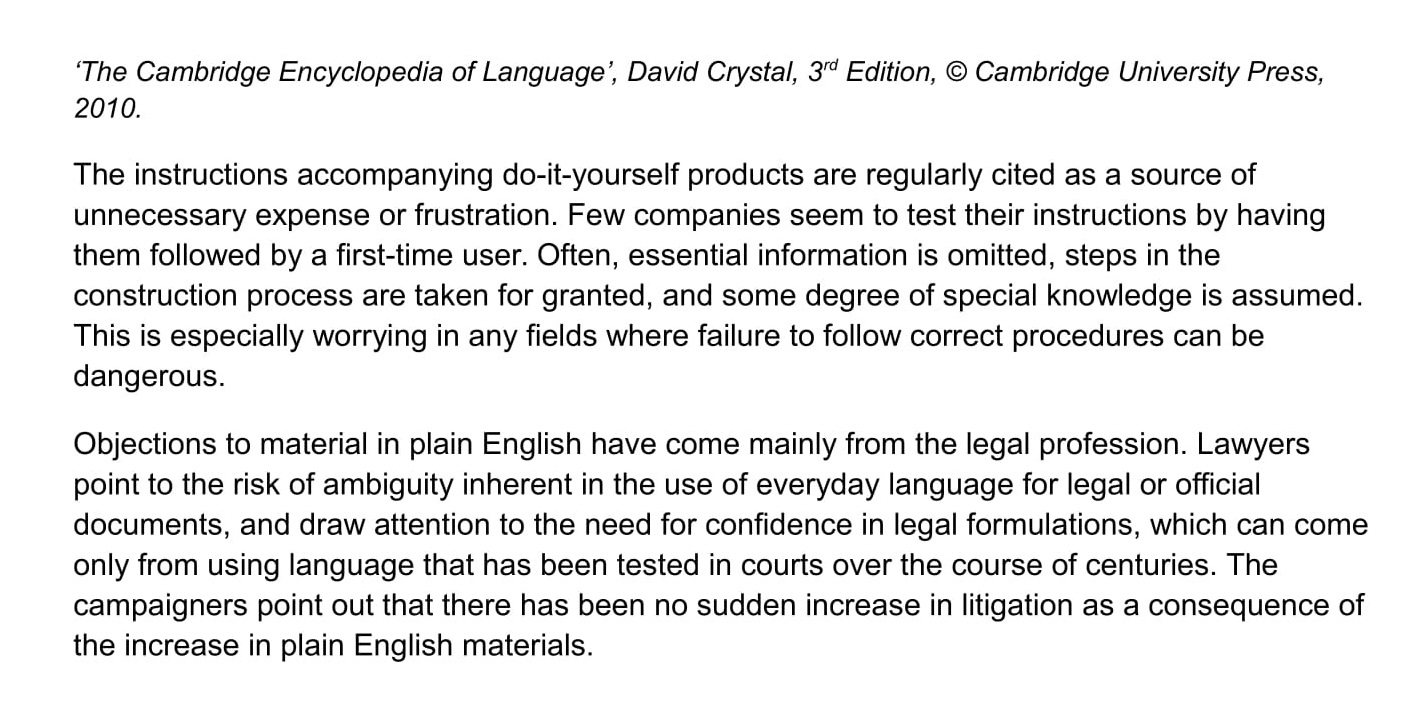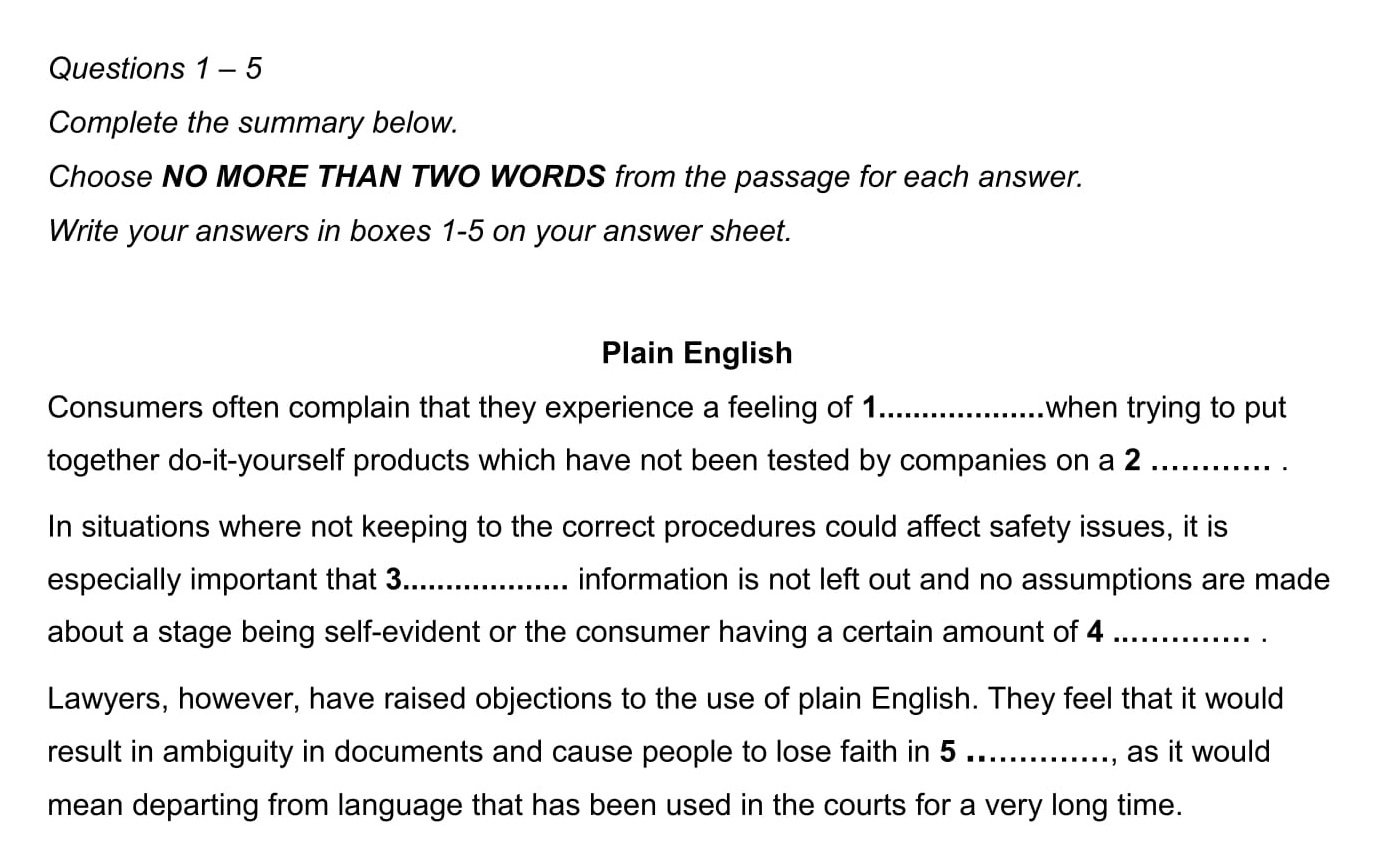IELTS Reading
Summary Completion Questions
Summary completion questions appear regularly in the IELTS Reading test so you need to learn how to answer them.
I cover all you need to know on this page. It includes:
- Explanation of this question type
- Skills needed
- Key tips
- The strategy
- Examples from real test papers
Explanation of this question type
First, I want to be sure that you understand what a summary is.
A summary is:
‘a short, clear description that gives the main facts or ideas about something’.
In this case, it’s a short summary of information from part of the text that’s been set for your reading test.
For summary completion questions, you will be given:
1) The text.
2) A summary of information from a section of the text with some gaps where words have been missed out.
You may also be given a list of words to fill the gaps with.
You will be required to do one of the following tasks:
a) Fill in the gaps with words from the word list
or
b) Fill in the gaps with words from the text.
Here are two sets of instructions from the official IELTS website to illustrate the two different forms of summary completion questions.
Selecting from a list of words or phrases
* Note that there are more words in the list than are needed to fill the gaps.

Source: Official IELTS website ielts.org
Selecting words from the text

Source: Cambridge English Past Test Paper
Skills needed
This type of question tests your ability to:
- Skim the summary for general meaning.
- Scan the text for specific information.
- Identify key words.
- Recognise synonyms & paraphrasing.
- Use context to make predictions.
Key tips
1) Vocabulary –
Summary completion questions are all about vocabulary. You need to be able to
recognise a wide range of synonyms and also paraphrasing to score highly.
2) Answer order – The answers are usually in the same order in the text as the order of the missing words. On the rare occasions that they aren’t, the key words will help you to easily spot this.
3) Words from text questions – Take careful note of how many words you should write for your answer, e.g. NO MORE THAN TWO WORDS. If you write more than this, your answer will be marked wrong even if the information is correct.
4) List of words questions – There will be more words in the list than there are gaps in the summary to fill so you won’t need them all. Your task is to select the correct ones.
There will probably be some words in the list that you can eliminate immediately as clearly being incorrect. This could be because of their meaning or their grammar form. Cross them through in pencil so you don’t waste time considering them.
5) Prediction – When you read the summary, try to predict the type of word you’ll need to fill each gap from the context of the sentence. Is it an adjective, a noun, a verb, etc? Doing this will make it much easier to spot the correct word because you’ll have a big clue as to what you’re looking for.
6) Use other clues – If you are able to predict the word form, e.g. an adjective, look for the adjective closest to the key word in the text. This will probably be the word you need or a synonym of it. I’ll illustrate this when we come to the example exercise.
7) Time management – If you’re struggling to find a specific missing word, take an educated guess and move on. It’s not worth losing too much time on it. Focus on getting the easier marks and come back to it later if you have time.
8) Check grammar – When you’ve entered your answer, check the sentence to ensure that it is grammatically correct. If it isn’t, your answer is wrong.
9) Don’t read it all – You don’t need to read the whole text in detail, just the part that is summarised.
The Strategy
# 1 Carefully read the instructions taking
particular note of where you should get the missing words from – a word list or
the text. If it’s the text, note the word limit for your answer, e.g. no more
than two.
# 2 Skim read the summary to get a general understanding of what it’s about.
# 3 Next, read the summary in more detail and try to predict the type of word needed to fill each gap, e.g. verb, noun, adjective, and what that word might be. Don’t spend too long on this but it will save you time later if you do it.
# 4 If the question includes a list of words, see if you can guess any answers. You may be able to narrow it down to 2 or 3. There will be others that will obviously be wrong.
# 5 The summary will normally relate to one section of the text, probably 2-3 paragraphs. Your next job is to identify this.
Pick out a few key words from the summary to scan for. Names, numbers, places or dates are ideal if there are any in the summary as these will be easy to spot. Remember that synonyms could be used. When you’ve made your selection, scan the text for them.
# 6 Read the first sentence of the summary with a gap in it. Try to work out what form of word will fit, e.g. an adjective, the past tense of a verb, a countable noun. You may even be able to predict the missing word itself or a synonym.
# 7 Identify one or two key words and scan the section of text for them, watching out for synonyms and paraphrasing.
# 8 When you’ve found the part of the text with the answer in, read it in detail to identify the word you need, either in the text itself or from the word list.
# 9 Check your answer to ensure that the sentence is grammatically correct.
# 10 Repeat this process for the rest of the missing words.
Example with answers
This example comes from the
official IELTS website, www.ielts.org. Before checking the answers, see if you can
fill in the gaps in the summary following the steps in the strategy.
This text is just a small portion of the whole text used in this real exam paper. It is the part that has been summarised so you won’t need to complete those steps of the strategy for this exercise. In your exam, you will be working with a much longer text.
When you’ve completed the task, read my notes below which contain the answers.
Text


Source: Official IELTS website ielts.org - Summary Completion Sample Text
Notes on how I answered the questions
1) Having read the instructions and identified this as a summary completion question where I have to find the missing words in the text, I note that I must choose NO MORE THAN TWO WORDS from the passage for each answer.
I already have the section of text that has been summarised so I get straight down to locating the first missing word at step # 6.
(The first five steps are quite simple so don’t worry that we’re not practicing them here. You'll have a chance to work through them in other practice questions on the website.)
On reading the sentence in the summary, I can tell that the answer will be a noun because it's going to be a type of feeling.
Consumers often complain that they experience a feeling of 1.................... when trying to put together do-it-yourself products which have not been tested by companies...
From
the context of the sentence, I can even make an educated guess as to what the missing word is. I know that my own feeling of ‘trying
to put together do-it-yourself
products’ is often ‘frustration’.
I select do-it-yourself products as the key word phrase to scan the text for. I find it in the very first sentence. I then read the whole sentence in detail and confirm that the answer is, indeed, frustration.
The
instructions accompanying do-it-yourself products are regularly cited as a
source of unnecessary expense or frustration.
I fill in my
answer and, before moving on, read the sentence to double-check that it is
grammatically correct.
Answer 1: frustration
2) The second answer comes in the same sentence in the summary as the first. I re-read the sentence and choose key words in the final phrase to help me locate the matching information. I select ‘not tested’ as this is the main idea.
I also know that I’m looking for another noun as the missing word had an article in front of it – ‘a’.
Consumers often complain that they experience a feeling of 1 (frustration) when trying to put together do-it-yourself products which have not been tested by companies on a 2 ………… .
I scan on through the text and find the word ‘test’ in the next sentence. I read the sentence in detail to check if the information matches.
Few companies seem to test their instructions by having them followed by a first-time user.
It does. There is paraphrasing here but ‘Few companies seem to test their instructions’ means the same as ‘have not been tested by companies’.
I now just need to find the words that tell me who the product has not been tested on. I easily identify this to be a ‘first-time user’. I have my second answer.
Answer 2: first-time user
3) On reading the summary sentence containing the third missing words, I can see that it comes before a noun and is going to be an adjective describing the noun ‘information’.
In situations where not keeping to the correct procedures could affect safety issues, it is especially important that 3.................... information is not left out...
I take ‘information’ as my key word but am also mindful that a synonym might appear in the text.
I scan the text. The test setter has been kind and ‘information’ is in the next sentence.
Often, essential information is omitted, steps in the construction process are taken for granted, and some degree of special knowledge is assumed.
The answer is obviously going to be the adjective associated with it which comes right before it. It’s essential. That’s answer 3 found.
Answer 3: essential
4) The next gap is in the second half of the same sentence.
...and no assumptions
are made about a stage being
self-evident or the consumer
having a certain amount of 4 ………… .
Because of this, I guess that the answer might be in the same sentence in the text as the last one so I go back to the text and read it carefully, looking out for any words that match those in the summary sentence or are synonyms of them. I choose ‘assumptions’ and ‘consumer’ as key words to particularly watch out for.
Often, essential information is omitted, steps in the construction process are taken for granted, and some degree of special knowledge is assumed.
I spot the word ‘assumed’ so know I’m in the right place in the text. The sentence is paraphrased but even if I wasn’t sure of exactly what it meant, it’s clear that it is ‘special knowledge’ that is related to the word ‘assumed’. This, then, is the answer.
Answer 4: special knowledge
5) We now come to the final gap. It occurs in the middle of a long sentence. I’m not sure that I really understand what it’s about and how it's related to the main topic of the summary. This makes me feel anxious.
If you ever feel like this, don’t panic. Just stick to the strategy and you’ll be fine.
So, I select my key words as before. I think that ‘documents’, ‘language’ and ‘courts’ are the best ones to scan for.
They feel that it would result in ambiguity in documents and cause people to lose faith in 5 …………., as it would mean departing from language that has been used in the courts for a very long time.
I scan for them and soon identify the sentence containing the answer but there’s more work to be done to find the word or words I need.
Objections to material in plain English have come mainly from the legal profession. Lawyers point to the risk of ambiguity inherent in the use of everyday language for legal or official documents, and draw attention to the need for confidence in legal formulations, which can come only from using language that has been tested in courts over the course of centuries.
I’ve also noticed that the word ‘ambiguity’ appears in both the text
and the summary and that the phrases ‘for a long time’ and ‘over the
‘centuries’ match. Neither, however, provide the answer so I must read
deeper.
What I need to do is focus on the words in the summary that specifically relate to the missing word. They come immediately before it and are, ‘to lose faith in’. I go back to the text and read carefully to try and spot a word or phrase with a similar meaning.
There’s nothing obvious but I know that the word ‘confidence in’ is a synonym of ‘faith in’ so I make an educated guess that the answer will be here.
The next two words are ‘legal formulations’. I don’t know what this means but it would seem to fit into the context of the sentence and sounds grammatically correct so, without wasting more time, I put it as my answer.
Answer 5: legal formulations
Answers
1 frustration
2 first-time user
3 essential
4 special knowledge
5 legal formulations
Want to watch the video of this page? Click here.
I hope you’ve found these extra notes helpful. Now you’re ready to use this strategy and all the tips to practice answering summary completion questions from past IELTS Reading test papers. This practice will quickly improve both your skills and your level of confidence.
Like this page?
Lessons On All Question Types
For more sample questions with step-by-step instructions, see the IELTS Reading menu page.
More Reading Test Pages
IELTS Reading Test – Understand the format, question types & marking system & know what skills are assessed. Also learn success strategies, key reading skills & discover top tips.
IELTS Reading Skills – Master the skills of skimming, scanning & detailed reading. Understand the importance of topic sentences & how to use context for meaning & unfamiliar words.
Top 7 IELTS Reading Tips – Each tip will take you a step closer to the high score you want. They are the key to top marks in your test.
9 More Tips For IELTS Reading – Learn valuable practice techniques & discover a secret that may gain you extra marks.
IELTS Reading Practice – Discover the top 5 things you must do to prepare for your reading test.
How to Complete the IELTS Reading Test in 60 Minutes – Top 6 Recommendations.
IELTS Academic Reading – Why you should take IELTS Academic Reading, test format, text types &
sample tests.
IELTS General Reading – Why you should take IELTS General Reading, test format, text types & sample tests.
Reading Practice Samples – Short activities to improve your reading skills & help you learn topic vocabulary.









